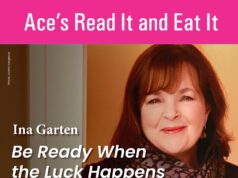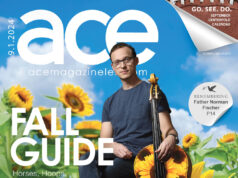‘Telling Kentucky’s Story Through the Arts’
A Conversation with Bob Stewart, Kentucky’s Secretary of Tourism, Arts, and Heritage
BY LAURA GLASSCOCK

Reflecting on the first Three Day Event in 1978, he was in Governor Carroll’s office, “learning the proper protocol and crafting appropriate letters of invitation from the governor to the heads of state of all the countries that would be competing… Then, in the 1980s, under Gov. Collins, when we opened an economic development office in London, I got involved in the office opening, and we sent communications to Her Majesty the Queen, because she had been to Kentucky a couple times. So, we wanted to reach out to the palace, and Gov. Collins sent a letter. The queen declined to come to the office opening, but she invited the governor to a private lunch at Windsor Castle…So, I always seemed to be drawn into activities where you get to pull together and show off the state and explain to visitors what is so special about this place – as I know to be special, since I’m a 7th or 8th generation Kentuckian.
Did Gov. Collins go to the luncheon at Windsor Castle?
“Absolutely. She absolutely did. That was the high point of the trip. That made a lot more news than the opening of our office…That was back when the craft program had just started. Phyllis George Brown, in the previous administration, had really gotten Kentucky crafts (known) on a national level. … I was involved in one of the first trips to the New York gift show, when we took a group of Kentucky craft people up there to introduce them to buyers who bought for retail outlets all over the country and the world – it’s where art met commerce, which I found really interesting…It was always so heartening for us to see these sophisticated, and sometimes jaded, buyers walk down the aisle of that big exhibition hall, and they would come to our booth, and they would stop, and they would look, and they would talk with a quilter or a basket-maker or a potter, and they could not believe the quality…. Again, we got to tell Kentucky’s story through the arts.”
“Tourism is really the commercial presentation, if you will, of our state’s beauty and culture. And you can do that without exploiting it. We do it in a way that we hope will preserve it, promote it and protect it.”
“Tourism, and the arts, and history and heritage, support jobs and cause commerce to happen. People come here and vacation, and they spend money. The arts – people come here and buy crafts or they go to a performance or they walk through the doors of a historical home or a museum. That’s commerce. But the bigger picture, and an even more important role, perhaps, is that each of those things help position Kentucky to attract new investment. If a community has a vibrant tourism trade, if they have a vibrant arts community, and if their historic resources are preserved and presented appropriately to the public, that is going to position the community very competitively to attract other types of investment. People who are looking to locate a plant or any sort of venture in a community, if they see (art) in a community, then it speaks to the quality of life of that community.
“The investor wants to invest in the training of workers and the workforce they’re going to attract, they want to do that in a place that has a great quality of life, because a lot of times those corporate executives or their employees are going to be living there. And if they locate these companies, these plants, in attractive places, then as a company, they’re probably going to be able to attract the talent they want to come and be a part of that company, too. It’s all interconnected. And most important, it assures that the people living in that community have a great quality of life.”

Eastern Kentucky is often cited as a beautiful region with a lot of potential, but there are problems in that area if you compare it to, say, East Tennessee. Does the cabinet have any proposals, a strategy for developing regions?
“Before I get into that, let me say, I grew up in Frankfort; this is my hometown. But I have a special interest in Eastern Kentucky. I love Western Kentucky, too; I certainly don’t want to indicate (a preference). Eastern Kentucky is one of the most interesting, compelling places in America for many reasons. The arts and culture that are there, and the history, and the geographic contrasts that you have, create a region that is just interesting, and almost a little mysterious at times.
Now, it is a part of the state that is undergoing the greatest economic shift. As the coal industry faces increasing challenges, there’s been a lot of work and a lot of talk of diversifying the economy if coal is not to be as lucrative as it has been for generations, which is what the current market situation would suggest. Then we need to diversify the economy, and when you look at what Eastern Kentucky has in terms of the natural resources, the great literary figures that have come out of Eastern Kentucky, and the artists, and the folk artists, and the music that has come out, that’s a pretty impressive combination for creating a tourism industry.
And it is there. The tourism industry is in Eastern Kentucky; it’s in many hills and hollows. What it doesn’t have is, I guess, what you would call the anchor attraction. There is no Dollywood, there is no Gatlinburg per se, it’s more spread out…”
As the state’s funding is tight and we’re coming out of the economic recovery, as you’ve noted, and some agencies are looking at service cuts and wanting more money for education, for example, what do you tell people who might think the arts are a luxury?
“Well, the arts is education. I’m a firm believer that your brain, your intellectual capabilities don’t even fully develop unless you’re exposed to the arts. I know there are people who reject that notion; I absolutely embrace it.
The arts are core to our lives as human beings. As thinking, creative, growing, evolving people, you can’t do that without the arts. You can’t. It’s essential to life.
To see the arts not as predominantly taught in schools is a great disappointment to a lot of people, and it concerns me very much. So, that’s why any and all ways we can make art more accessible to the public at every level and at every venue, the better it will be long term. Not only for us as a human beings, but for our society.
So, I’m a big proponent of making art available and accessible, and art does not need to be reserved for a certain group of people. Art is for everyone and it needs to be present everywhere in our lives.
We’re going to do a study, we’re going to look at the arts and really look at its economic impact in Kentucky and how the arts relate to other parts of Kentucky and how it fits in. And I think that will go a long way toward (negating), ‘Arts are like the frosting on the cake, but it’s not really part of the cake.’ Well, it is part of the cake. It is intrinsically a part of the cake – of commerce and education, and everything else – it’s important. I’m really excited about that, because it’s taking a look at the arts in a way that we have not looked at either ever or for a long time. I think we’ll see lots of insights about that that will help us build a case for arts funding.”
Plus, there is the economic impact…
“There is absolutely the economic impact, and the quality of life component, and our development as human beings is dependent upon it. How we got to the notion that art was not really as important as math or science, I don’t know. …
Tuesday night, I was at the Governors School for the Arts, they had a reception and we got to go in and watch the kids rehearsing in different disciplines, and it reaffirms that we are going to be O.K., this state is going to be O.K., because look at these kids. These kids breathe life into you, because they’re living the arts and they love the arts, and it really is exciting to see that. I saw the kids in musical theatre, and they were all spectacular. So we had 1,800 applications and 200 slots. So, we have 1,600 kids – there’s no outlet for them. Wouldn’t it be wonderful if every kid that wanted to be in GSA could do so? …”
“We want to really look at and retool some of our traditional tourism marketing and do some more public-private partnerships with marketing to try to stretch our dollars. Look at all the platforms that are now available to us. You know, there are platforms available to us now that were not available when I left 10 years ago. There was no social media…”
“Kentucky was the first state in the nation to have an extensive program that was designed specifically to attract tourism investment. It’s different from the type of investment that you see the Economic Development Cabinet attract. In 1996, we passed the first Tourism Development Act, and it’s been tweaked a couple of times. A tourism investor who brings a new business in, such as the Newport Aquarium, can recoup up to 25 percent of their investment every 10 years through sales tax rebates. So, it’s based on economic activities that it generates as opposed to numbers of jobs and that kind of thing.”
“I’m interested in getting the word back out there about the Tourism Development Act and maybe try to attract new investments in Kentucky. Same with the film office. I’d like to maybe do a bit of very targeted marketing to the film industry and those people who make the decisions as to where films are shot and make sure filmmakers and people working in the industry in Kentucky know the program is there so these great Kentucky-grown film projects will take advantage of the program as well.”
A big-budget movie project or a reality television series, or any television series, can drop an incredible amount of money in a very short time and leave no footprint. They come in, they use your services, and they drop the money, and they shoot the film and they’re gone.”





